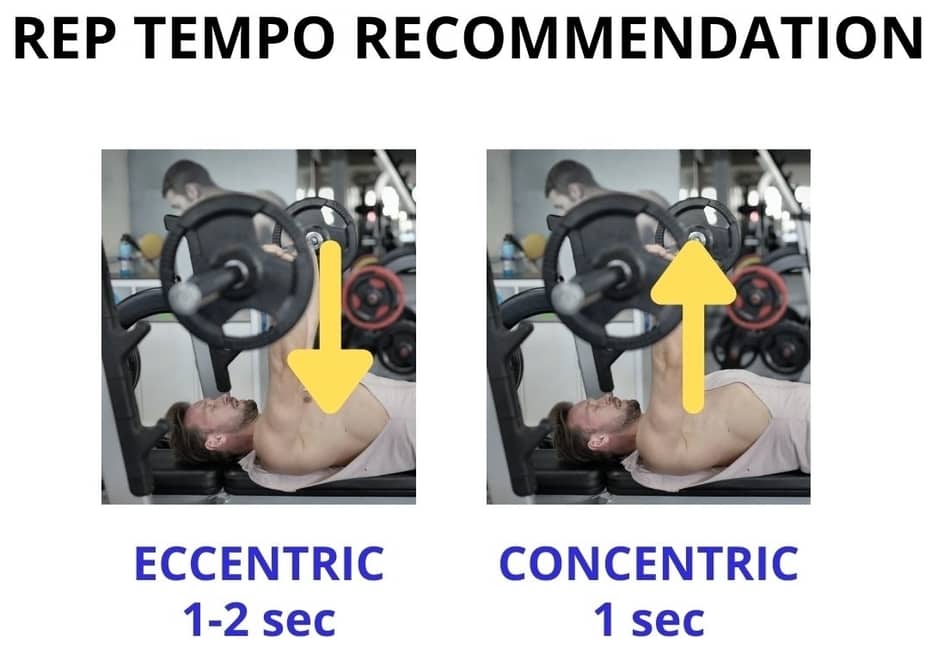
One training variable that is important yet often overlooked when trying to maximize muscle growth is rep tempo – how fast you should perform your reps.
Yet this is an important factor in considering muscle growth.
If you’ve ever seen people thoughtlessly throwing around weights in the gym, you know exactly what I’m talking about. I’ll tell you right now, that’s not very effective!
So in this article, I will tell you what is effective. And I will provide science-based information regarding the optimal rep tempo for maximizing muscle growth.
The Benefit of Slow Reps
The primary benefit of lifting at a slower tempo is to increase time under tension – the amount of time your muscles are held under tension.
The idea here is that a slower rep tempo requires your muscles to work harder, theoretically leading to more muscle growth.
With a slow rep tempo, you also benefit from increased mind muscle connection. This refers to really being able to feel the muscle you are working out, leading to more stress on the muscle.
For example, if you perform a push up with a slow and controlled tempo, you will feel your chest, shoulders, and triceps working more than if you quickly crank out a bunch of reps.
That being said, there are limitations to performing your reps with a slower tempo that you do not experience if you lift the weight at a faster tempo.
The Benefit of Fast Reps
While lifting at a faster tempo may reduce time under tension, the primary benefit is that you can lift more weight.
This allows you to produce more force and engage more muscle fibers, which in turn, should lead to more muscle growth.
So the question is – which one is more effective? Slower reps or faster reps? To find the answer, let’s see what the research shows.
The Research on Optimal Rep Tempo
One 2008 study looking at muscle growth compared individuals engaging a slower rep tempo to those engaging a faster rep tempo. One group performed reps for 2 seconds and the other group performed the same number of reps for 6 seconds each.
After 13 weeks, the researchers found that whole body muscle thickness was similar in both groups, suggesting that both rep tempos were equally as effective at creating muscle growth.

Given that there is a significant difference between the time it takes to perform a 2 second rep versus a 6 second rep, it can be inferred that time under tension is not the primary factor considering optimal muscle growth.
Dr. Brad Schoenfeld conducted a meta-analysis in 2016 and found similar results. This meta-analysis reviewed 8 studies and found that muscle growth outcomes are similar when training with repetition durations anywhere from .5 seconds to 8 seconds.
As a result, it seems that a wide variation of rep tempos can work for optimizing muscle growth.
They also reported that training with very slow repetition durations (such as more than 10 seconds per rep) resulted in less muscle growth, indicating that there is a point at which slowing down the repetition further is inferior.
This makes sense given that if you perform your reps too slowly, you will be required to use a very light weight, meaning the intensity of your set will be quite low.
My Recommendation
Based on the research, there seems to be a wide variety of rep tempos that lead to optimal muscle growth. That being said, here is my recommendation.
I recommend, for the most part, performing the concentric part (pressing the weight) of the repetition at a faster tempo than the eccentric part of the exercise (lowering the weight).
Perform the concentric for 1 second and the eccentric for 1-2 seconds.
For example, with the bench press, lower the weight to your chest in 1-2 seconds (eccentric) and then press the weight up in about 1 second (concentric).

In a push up, lower your body towards the floor in 1-2 seconds (eccentric), and press yourself back up to the starting position in 1 second (concentric).
If you are performing a squat, squat down in 1-2 seconds (eccentric) and stand back up in 1 second (concentric).
This repetition speed ensures that you are maintaining control over the weight and performing high quality reps, while also being able to lift heavy weights.
While this general guideline should be considered most of the time, there are situations where I would recommend performing a slower rep. If you have trouble “feeling” the muscle you are working out, then slowing down your tempo can be helpful.
For example, if you are doing a tricep extension and have trouble feeling a “squeeze” in your triceps, slow down the movement while focusing on on the mind muscle connection.
Optimal Rep Range for Strength
So far, we have looked at the research regarding rep tempo and muscle growth. However, you might be wondering what rep tempo is optimal for gaining strength.
After all, while the two are related, they are not the exact same. Without getting into it too much, strength training targets muscles in a way that makes them stronger, while building muscle targets muscles in a way that makes muscles larger.
Gaining strength will lead to larger muscles, and vice versa, so there is a relationship, but I wanted to point out how they are not exactly the same thing.
When it comes to strength gains, the research actually suggests there is a difference in rep tempo that should be understood.
Research shows that when trying to optimize strength gains, it is more beneficial to perform faster reps as opposed to slower reps.
This is because when you lift weights faster, you engage more fast-twitch muscle fibers, which produce more muscle force (strength).
This isn’t to say you should be throwing the weight around – you still want a controlled tempo. However, when trying to maximize strength gains, you don’t need to pay as close attention to the rep tempo recommendations I provided earlier for muscle growth.
Summary
- While there is no “strict rule” in optimizing muscle growth, I would typically recommend a 1 second concentric and a 1-2 second eccentric.
- To optimize strength gains, a faster tempo will be optimal, allowing you to lift more weight.
- Finally, if you struggle to “feel” the muscle you are working, slow down the rep tempo and focus on the mind muscle connection.
I hope you found this article helpful. If you have any questions or comments, please leave them below and I will be sure to get back to you!

